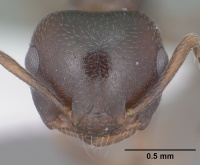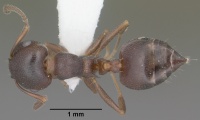Crematogaster isolata
| Crematogaster isolata | |
|---|---|

| |
| Scientific classification | |
| Kingdom: | Animalia |
| Phylum: | Arthropoda |
| Class: | Insecta |
| Order: | Hymenoptera |
| Family: | Formicidae |
| Subfamily: | Myrmicinae |
| Tribe: | Crematogastrini |
| Genus: | Crematogaster |
| Species group: | scutellaris |
| Species: | C. isolata |
| Binomial name | |
| Crematogaster isolata Buren, 1968 | |
An uncommon species that nests in dead branches of oaks (Quercus arizonica), at altitudes over 1500m. (Mackay and Mackay 2002)
Identification
A member of the Crematogaster scutellaris group.
Buren (1968) - This species is not closely related to any species occurring in the United States except Crematogaster emeryana (as marioni), which can be easily separated by its pilosity. Since their ranges appear completely allopatric, probably no confusion will arise. The distinctive epinotum of isolata (see description) will clearly distinguish this new species from all other species in the United States. C. isolata appears to be the only arboreal species of this subgenus other than emeryana which nests in oaks (and perhaps also manzanita) at altitudes over 5000 ft. in the southwestern mountains. Crematogaster laeviuscula (as hespera), a quite different species, is largely confined to cottonwoods at lower altitudes.
Keys including this Species
Distribution
Latitudinal Distribution Pattern
Latitudinal Range: 34.156971° to 19.407857°.
| North Temperate |
North Subtropical |
Tropical | South Subtropical |
South Temperate |
- Source: AntMaps
Distribution based on Regional Taxon Lists
Nearctic Region: United States (type locality).
Neotropical Region: Mexico.
Distribution based on AntMaps
Distribution based on AntWeb specimens
Check data from AntWeb
Countries Occupied
| Number of countries occupied by this species based on AntWiki Regional Taxon Lists. In general, fewer countries occupied indicates a narrower range, while more countries indicates a more widespread species. |

|
Estimated Abundance
| Relative abundance based on number of AntMaps records per species (this species within the purple bar). Fewer records (to the left) indicates a less abundant/encountered species while more records (to the right) indicates more abundant/encountered species. |

|
Habitat
Mountainous areas.
Biology
Castes
Nomenclature
The following information is derived from Barry Bolton's Online Catalogue of the Ants of the World.
- isolata. Crematogaster (Crematogaster) isolata Buren, 1968b: 106 (w.) U.S.A. (Texas, Arizona, New Mexico).
- Type-material: holotype worker, paratype workers (number not stated).
- Type-locality: holotype U.S.A.: Texas, Davis Mts, a few mi. N McDonald Observatory, 14.x.1959 (W.F. Buren); paratypes: “a number” with same data, 10 workers Texas, Davis Mts, Limpia Canyon, 5500 ft (L.F. Byars), U.S.A.: Arizona, Santa Rita Mts, Madera Canyon, 21.vi.1951(W.S. Creighton), Santa Rita Mts, Sweetwater, 2.vii.1951 (W.S. Creighton), Arizona, Huachuca Mts, Garden Canyon, 5800 ft (W.S. Creighton), Arizona, Santa Cruz County, Canelo Pass, 28.viii.1951 (W.S. Creighton), Arizona, Chiricahua Nat. Monument, 20.ix.1951 (W.S. Creighton), “1 specimen” Arizona, Guadalupe Mts (L.F. Byars), “1 specimen” Arizona, Huachuca Mts (L.F. Byars), U.S.A.: New Mexico, Animas Mts, San Luis Pass, 5400 ft, 28.ix.1951 (W.S. Creighton), .
- Type-depositories: USNM (holotype); CASC, LACM, MCZC, USNM (paratypes).
- Morgan & Mackay, 2017: 188 (q.m.).
- Status as species: Hunt & Snelling, 1975: 21; Smith, D.R. 1979: 1379; Bolton, 1995b: 155; Mackay & Mackay, 2002: 92; Morgan & Mackay, 2017: 186 (redescription).
- Distribution: Mexico, U.S.A.
Unless otherwise noted the text for the remainder of this section is reported from the publication that includes the original description.
Description
Worker
Head, excluding mandibles, slightly broader than long, with convex sides and posterior border excised in the middle. Scapes surpassing posterior corners by about one diameter, less in larger workers. Humeri of pronotum absent or weak. Pro-mesonotum in profile evenly but not strongly convex above. Mesonotal declivity absent or short and rounded. Meso-epinotal impression a strong and deep groove above, deeper than in any preceding species. Mesonotal carina weak or absent. Base of epinotum long, noticeably longer than in most species. Spines short, one half of interbasal distance in length or even less, straight, divergent, not slender or sharp. Base of epinotum from above somewhat convex or tuberculate at sides. Petiole slightly broader than long, angularly trapezoidal. Hemilobes of postpetiole elongate, more produced behind, with slightly convex sides from above. Median impression fairly strong, especially behind, not groove-like but a fairly wide, evenly concave impression.
Genae striato-punctate to about middle of eyes. Head subshining on front, vertex, occiput, and corners, sometimes corners smooth and shining. Sides of venter striato-punctate. Vertex and middle of occiput punctate. Front faintly punctate. Front of pronotum punctate, and there may be a shining median streak. Pronotal dorsum punctate. Pronotal sides with larger but weaker punctures, subopaque. Mesonotum punctate, subopaque. Mesopleura densely punctate. Metapleura punctate above and below. Base of epinotum punctate with a few longitudinal rugae or striae. Declivity smooth and shining. Petiole and postpetiole punctate, subopaque. Gaster with reticulate shagreen, subshining.
Pubescence moderately or quite short on all parts, appressed; subappressed on scapes. Erect hairs rather bristle-like, very sparse, one or none each shoulder on thorax, and two to four at most each segment of gaster, thus much sparser than in emeryana.
Head and thorax usually dark brown. Gaster black.
Type Material
The holotype and a number of paratypes were collected a few miles north of McDonald Observatory, Davis Mts., Texas, from a dead oak limb, Oct. 14, 1959, W. F. Buren. I have also marked as paratypes numerous specimens from the following localities: Madera Canyon, Santa Rita Mts., Ariz., June 21, 1951, crawling on manzanita, Wm. S. Creighton; Garden Canyon, Huachuca Mts., 5800', in dead oak stubs, Creighton (two records;) San Luis Pass, Animas Mts., N. Mex., 5400', Sept. 28, 1951, in Quercus emoryi, Creighton, (two records;) Sweetwater, Santa Rita Mts., Ariz., July 2, 1951, in dead oak stub, Creighton; Canelo Pass, Santa Cruz Co., Aug. 28, 1951, in dead oak limb, Creighton; Chiricahua Nat. Mon., Ariz., Sept. 20, 1951, in Quercus emoryi, Creighton. I have also seen and marked as paratypes a small series of 10 workers from Limpia Canyon, Davis Mts., Texas, altitude 5500 ft., and a single specimen each from the Guadalupe Mts. and Huachuca Mts., Ariz., L. F. Byars.
The holotype and a few paratypes from each series will be deposited in the National Museum. Other paratypes will go to the Museum of Comparative Zoology, the California Academy of Sciences, to the private collection of Dr. Creighton, and to my own private collection.
References
- Buren, W. F. 1968b. A review of the species of Crematogaster, sensu stricto, in North America (Hymenoptera, Formicidae). Part II. Descriptions of new species. J. Ga. Entomol. Soc. 3: 91-121. (page 106, worker described)
- Mackay, W.P. & Mackay, E.E. 2002. The Ants of New Mexico: 400 pp. Edwin Mellen Press, Lewiston, N.Y.
- Morgan, C.E., Mackay, W.P. 2017. The North American Acrobat Ants of the hyperdiverse genus Crematogaster (Hymneoptera: Formicidae). Lambert Academic Publishing (PDF version, 532 pp.)
- Ward, P.S., Blaimer, B.B. 2022. Taxonomy in the phylogenomic era: species boundaries and phylogenetic relationships among North American ants of the Crematogaster scutellaris group (Formicidae: Hymenoptera), Zoological Journal of the Linnean Society 194(3): 893–937 (doi:10.1093/zoolinnean/zlab047).
References based on Global Ant Biodiversity Informatics
- Bodner G. 2005. Invertebrates of the Peloncillo Region: Richness and Mystery. In Bodner, G.S., J. Atchley Montoya, R. Hanson, and W. Anderson, Editors. 2006. Natural heritage of the Peloncillo Mountain Region: a synthesis of science. World Wildlife Fund and Sky Island Alliance, Tucson, AZ. Available at skyislandalliance.org/media/Peloncillo%20Report.pdf
- Buren W.F. 1968. A Review of the species of Crematogaster, Sensu Stricto, in North America (Hymenoptera, Formicidae) Part 2. Descriptions of New Species. J. Georgia Entomol. Soc. 3: 91-121
- Cover S. P., and R. A. Johnson. 20011. Checklist of Arizona Ants. Downloaded on January 7th at http://www.asu.edu/clas/sirgtools/AZants-2011%20updatev2.pdf
- Hunt J. H. and Snelling R. R. 1975. A checklist of the ants of Arizona. Journal of the Arizona Academy of Science 10: 20-23
- Johnson R. Personnal Database. Accessed on February 5th 2014 at http://www.asu.edu/clas/sirgtools/resources.htm
- Longino, J.T. 2010. Personal Communication. Longino Collection Database
- Mackay W. P., and E. E. Mackay. 2002. The ants of New Mexico (Hymenoptera: Formicidae). Lewiston, New York: Edwin Mellen Press, 400 pp.
- Moody J. V., and O. F. Francke. 1982. The Ants (Hymenoptera, Formicidae) of Western Texas Part 1: Subfamily Myrmicinae. Graduate Studies Texas Tech University 27: 80 pp.
- Morgan C., and W. P. Mackay. 2017. The North America acrobat ants of the hyperdiverse genus Crematogaster. Mauritius: LAP LAMBERT Academic Publishing, 540 pp.
- Morgan, C.E. 2009. Revision of the ant genus Crematogaster (Hymenoptera: Formicidae) in North America. Ph.D. Dissertation, University of Texas at El Paso, 268 pp.
- O'Keefe S. T., J. L. Cook, T. Dudek, D. F. Wunneburger, M. D. Guzman, R. N. Coulson, and S. B. Vinson. 2000. The Distribution of Texas Ants. The Southwestern Entomologist 22: 1-92.
- Van Pelt, A. 1983. Ants of the Chisos Mountains, Texas (Hymenoptera: Formicidae) . Southwestern Naturalist 28:137-142.
- Wheeler, G.C. and J. Wheeler. 1985. A checklist of Texas ants. Prairie Naturalist 17:49-64.

